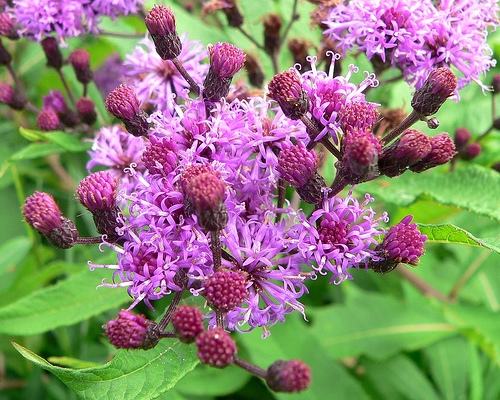Giant Ironweed
(Vernonia gigantea)
Giant Ironweed (Vernonia gigantea)
/
/

Arx Fortis
CC BY-SA 3.0
Image By:
Arx Fortis
Recorded By:
Copyright:
CC BY-SA 3.0
Copyright Notice:
Photo by: Arx Fortis | License Type: CC BY-SA 3.0 | License URL: http://creativecommons.org/licenses/by-sa/3.0/ | Uploader: FSock | Publisher: Wikimedia Commons | Title: Vernonia_altissima.jpg | Notes: Created by [[User:Petaholmes]] {{GFDL}} |
















































Estimated Native Range
Summary
Vernonia gigantea, commonly known as Giant Ironweed, is a deciduous perennial herb that thrives in open woodlands, meadows, and along stream banks in the Central and Eastern United States. It typically grows to heights of 0.9–2.1 meters (3–7 feet) and spreads 0.3–0.6 meters (1–2 feet) wide. The plant features robust, upright stems and lance-shaped leaves, creating a striking vertical accent in the landscape. From July to September, it produces clusters of small, fluffy, purple flowers that are highly attractive to butterflies and other pollinators. The flowers are quite showy, and the seeds that follow are adapted for wind dispersal. Giant Ironweed is self-incompatible, meaning it requires cross-pollination from another plant to set seed, which contributes to its genetic diversity and broad geographic distribution.
Giant Ironweed is valued for its tall, stately form and vibrant purple flowers, which add color and texture to garden settings. It is often used in naturalistic plantings, wildflower meadows, and as a back-of-the-border plant in perennial gardens. This plant is adaptable to a range of moisture conditions, but it prefers consistently moist soils and can tolerate wet areas, making it suitable for rain gardens and riparian plantings. While it thrives in full sun, it can also perform well in part shade. Gardeners should be aware that in optimal growing conditions, Giant Ironweed can spread vigorously and may require management to keep it in check.CC BY-SA 4.0
Giant Ironweed is valued for its tall, stately form and vibrant purple flowers, which add color and texture to garden settings. It is often used in naturalistic plantings, wildflower meadows, and as a back-of-the-border plant in perennial gardens. This plant is adaptable to a range of moisture conditions, but it prefers consistently moist soils and can tolerate wet areas, making it suitable for rain gardens and riparian plantings. While it thrives in full sun, it can also perform well in part shade. Gardeners should be aware that in optimal growing conditions, Giant Ironweed can spread vigorously and may require management to keep it in check.CC BY-SA 4.0
Plant Description
- Plant Type: Herb
- Height: 5-8 feet
- Width: 3-6 feet
- Growth Rate: Moderate
- Flower Color: Purple, Pink
- Flowering Season: Summer, Fall
- Leaf Retention: Deciduous
Growth Requirements
- Sun: Full Sun, Part Shade
- Water: Medium, High
- Drainage: Standing, Slow
Common Uses
Bee Garden, Bird Garden, Butterfly Garden, Deer Resistant, Hummingbird Garden, Low Maintenance, Showy Flowers, Water Garden
Natural Habitat
open woodlands, meadows, and along stream banks in the Central and Eastern United States
Other Names
Common Names: Tall Ironweed, Vernonie Géante
Scientific Names: , Vernonia gigantea, Vernonia gigantea var. gigantea, Vernonia altissima, Vernonia gigantea subsp. ovalifolia, Vernonia ovalifolia, Vernonia maxima, Vernonia oligantha, Vernonia altissima var. taeniotricha, Vernonia maxima var. pubescens
GBIF Accepted Name: Vernonia gigantea (Walter) Trel. ex Branner & Coville